The Glen of Imaal Terrier hails from a beautiful part of Ireland. Nestled away in the County Wicklow hills is the very remote location of the Glen of Imaal.
While this dog breed from Ireland is not particularly well known, it has some surprising characteristics including rarely barking, helping around the house and being exceptionally brave.
The more I researched this dog breed the more I fell in love with its robust charm.
Discover why this vulnerable dog breed is so special as well as all of the essential breed information in this article.
This article may contain affiliate links. If you click on one of them, we might receive a small commission (at no extra cost to you). Thanks for your support to help us keep this site running!
Table of Contents
- 1 Glen of Imaal Terrier Dog Breed
- 2 What is a Glen?
- 3 Where is the Glen of Imaal?
- 4 7 Glen of Imaal Terrier Facts
- 5 Irish Dog Breeds
- 6 Glen of Imaal Terrier Breed Characteristics
- 7 Glen of Imaal Terrier Maintenance
- 8 What is the life expectancy of a Glen of Imaal Terrier?
- 9 Are Glen of Imaal Terriers healthy?
- 10 How much should I feed my Glen of Imaal Terrier?
- 11 How much exercise does a Glen of Imaal Terrier need?
- 12 Glen of Imaal Terriers Dog Training
- 13 Glen of Imaal Terrier Temperament and Personality
- 14 Are Glen of Imaal Terrier rare?
- 15 Glen of Imaal Terrier Breeders
- 16 Glen of Imaal Terrier Breed Clubs
- 17 The History of the Glen of Imaal Terrier Ireland
- 18 Native Irish Dog Breeds
Glen of Imaal Terrier Dog Breed
In a remote part of the Wicklow Mountains on the east coast of Ireland lies the Glen of Imaal. This isolated place is thought to be the origin of the Glen of Imaal Terrier, the rarest of Ireland’s terrier dog breeds.
This dwarf dog breed is one with plenty of personality and skills as a working dog, however the Glen of Imaal Terrier is not a terrier Irish people know well.
World wide, it is also not a very well known breed.
In fact, according to the American Kennel Club, in terms of dog breeds, Glen of Imaal Terrier is one of the rarest of all 199 recognised breeds, ranking position 175 in 2021.
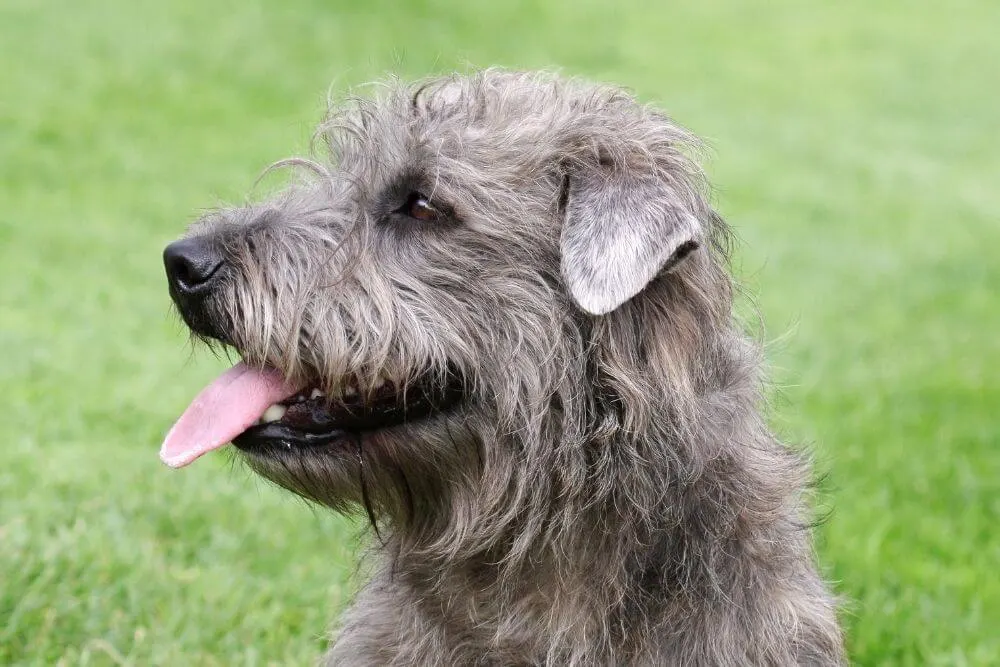
These little known, charming terriers have a strong prey drive which can be traced back to their work hunting small and medium-sized animals, such as foxes and badgers, underground in rural Ireland.
What is a Glen?
The Glen of Imaal Terrier goes by a few names, including “Glennie” or “Glen” for short.
Some great names for Glens can be found in our Dog Names from Ireland article.
This breed is also known as the Irish Glen of Imaal Terrier or in some cases as the “Wicklow Terrier” due to its origins. In Irish, the breed is called Brocaire Uí Mháil.
Did you know?
Even by Irish place name standards, the name “Imaal” is unusual.
It comes from Uí Máil who were an Irish dynasty who lived in and around what is now known as the Glen of Imaal in the province of Leinster during the 7th and 8th centuries.
Several of the Kings of Leinster came from the Uí Máil family.
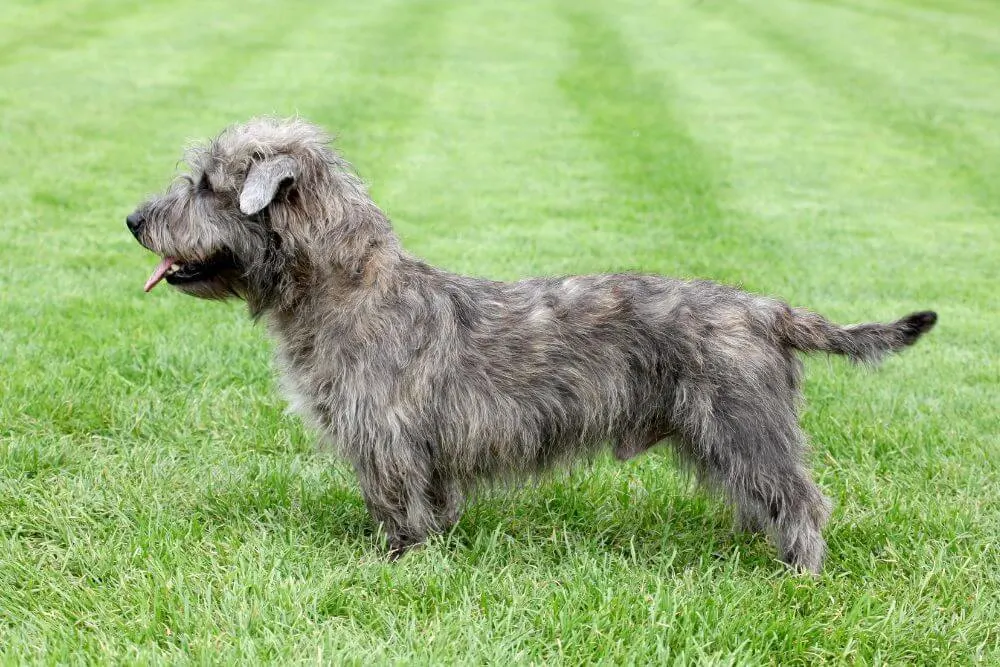
Where is the Glen of Imaal?
The Glen of Imaal is a remote valley in the Wicklow mountains on the east coast of Ireland, where the famous wicklow terrier hails from.
The rugged, picturesque terrain of the Glen of Imaal Ireland is now used by the Irish Defence forces as a military firing range. There is restricted access to this area.
For more information about the Glen of Imaal, designated walking routes and essential safety restrictions, please check the Irish Defence Forces website.
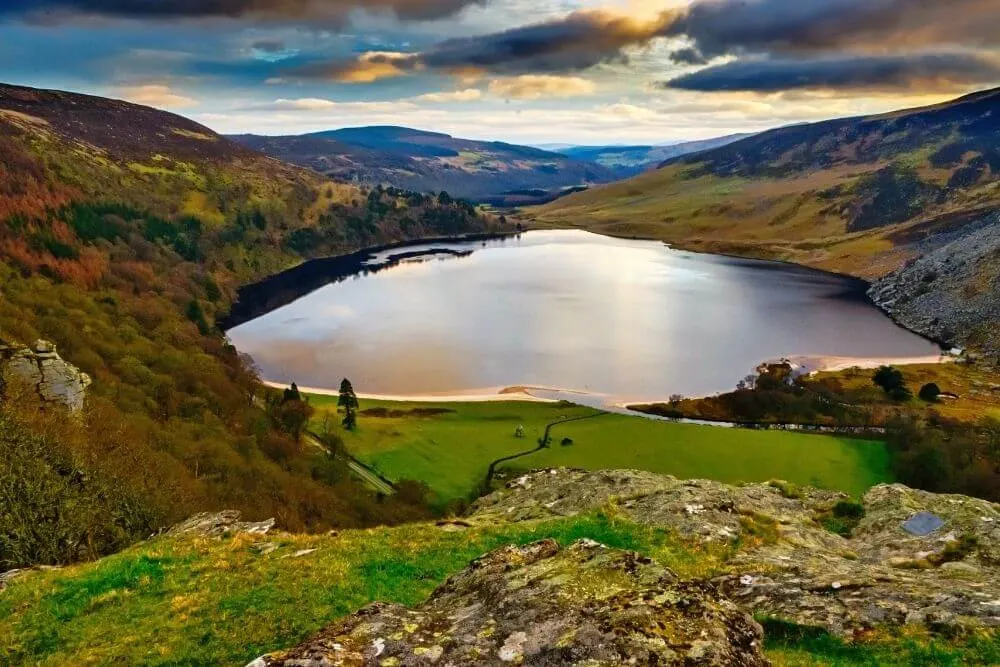
7 Glen of Imaal Terrier Facts
- The Irish Glen of Imaal Terrier is a dwarf breed with short legs and a normal size body (micromelic achondroplasia)
- The Glen of Imaal Terrier is named after one of the glens in County Wicklow, Ireland
- Can sit on its hind legs and perform the “Glen sit”
- Bred for their stealth and quietness, Glen of Imaal Terriers rarely bark
- Glen of Imaal Terriers are considered a vulnerable breed
- This breed may have been used as a type of “Turnspit dogs” to rotate meat cooking over a fire or butter in a churn in the 19th century.
- The name is one of the most misspelled dog breeds
Irish Dog Breeds
The Glen of Imaal Terrier is one of four Irish terriers. In total there are nine breeds of dog from Ireland. These are as follows:
- Irish Wolfhound
- Kerry Beagle
- Irish Terrier
- Kerry Blue Terrier
- Irish Soft Coated Wheaten Terrier
- Glen of Imaal Terrier (Glen or Wicklow Terrier)
- Irish Setter
- Irish Red and White Setter
- Irish Water Spaniel
Another well loved dog that is not officialy recognised as a breed is the Irish Doodle or Irish Setter Poodle Dog.
Glen of Imaal Terrier Breed Characteristics
The Glen of Imaal Terrier is often summed up as a “big dog on small legs” and this is essentially true because as a dwarf breed with micromelic achondroplasia, it is only the legs that are shorter, the other body parts are not reduced in size.
How tall is a Glen of Imaal Terrier?
The Glen of Imaal Terrier size is roughly 30-35 cm (12-14 inches) at the withers with females being smaller than the males.
The reduced leg height was an advantage for their working dogs as it enabled them to enter burrows, dens and in particular badger sets. While the animal may not be particularly tall, it is very sturdy and their strong, muscular bodies have the strength and agility necessary to hunt.
How much does a Glen of Imaal Terrier weigh?
Even though this dog breed is not particularly big, it is definitely solid and well built. A male Glen of Imaal Terrier typically weighs ca. 16-18 kg (35-40 lbs), while 14-16 kg (32-35 lbs) is a healthy female Glen of Imaal Terrier weight.
(This weight range is similar to that of a Staffordshire Bull Terrier, for example.)
What is the Glen sit?
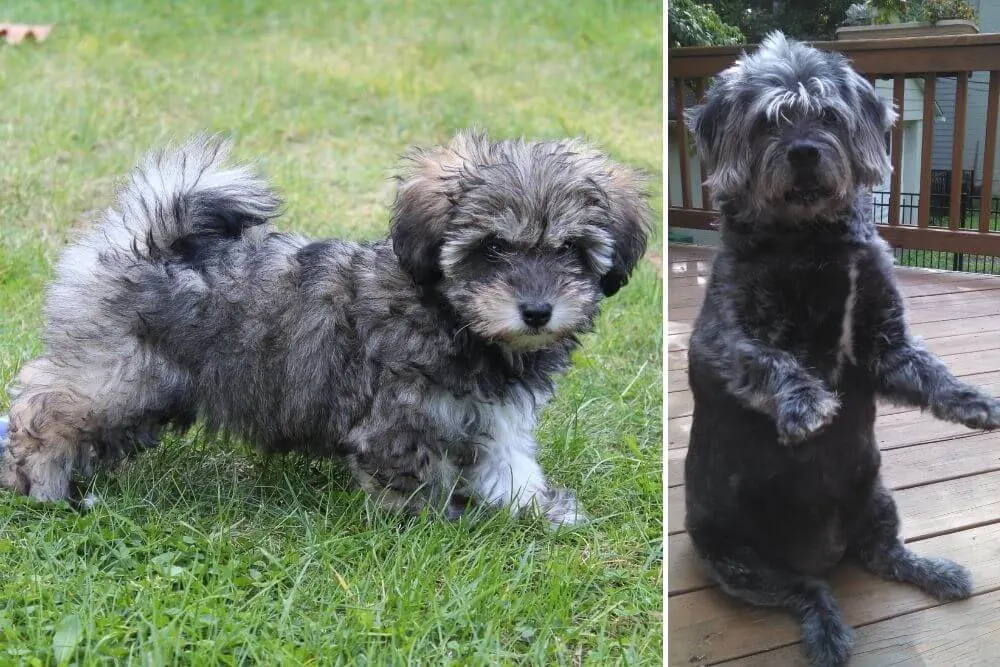
The low center of gravity and physical proportions (3 in height to 5 in length) of the Glen of Imaal Terrier enable the dog to hold itself erect in a position known as the “Glen Sit”. This ability is not commonly seen in dogs.
Can you teach the Glen to sit?
Yes. It is best to first teach the dog how to sit on command in the basic position and then help the dog into the Glen sit position by adjusting their legs as necessary. By using positive reinforcement techniques, including praise and treat rewards, it should be possible to train a Glen to do this.
What does a Glen of Imaal Terrier look like?
These ow slung dogsl are robust and stout in appearance. Their front legs are slightly curved and their hindlegs are very muscular.
Glens have long, broad heads and the wide-set ears are usually folded over on themselves, but do become more pricked when their attention is drawn to a noise. Their eyes are small, brown and always alert and their noses are black.
The tail of the Glen of Imaal Terriers is carried in an upright manner (roughly between (12 and 2 on the clock face). It is docked to half length in some countries. (In Ireland, this practice has been banned since 2014 and docked dogs can not be shown at dog shows)
While this breed may have a stock appearance, it is however very agile and can turn easily and quickly, which is an excellent advantage when hunting.
These dogs have rugged, wiry coats that are sometimes wavy. They come in a range of different colors, such as wheathen, blue and brindle.
What do Glen of Imaal Terrier puppies look like?
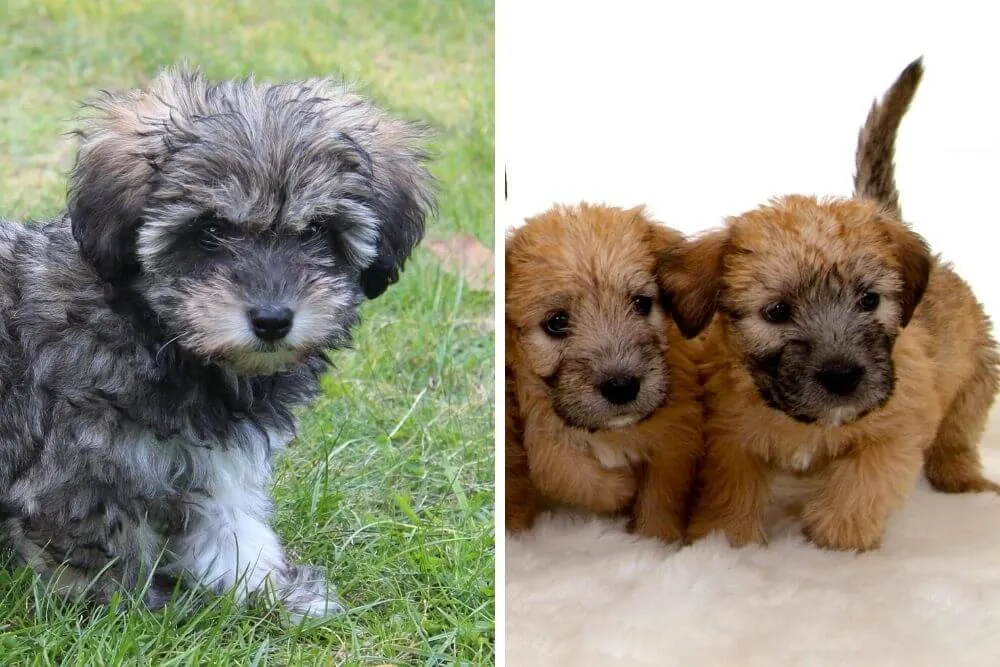
On the back of an Imaal Terrier Glen puppy, a darker dorsal stripe in their coats is sometimes visible when they are young. This coloration typically disappears before the dogs reach maturity. Glen of Imaal Terrier pups may also have darker highlights in their coats.
What dogs are similar to the Glen of Imaal Terrier?
All Irish terriers have mixed ancestry so it is probably fair to say that the long-legged terriers of Ireland, the Irish Soft Coated Wheaten Terriers, the Kerry Blue Terriers and the Irish Terriers are all distant cousins of the Glen of Imaal Terrier.
Glens also share some resemblance to the Dandie Dinmont Terrier from Scotland. Genetic analysis has also shown that there is some history of mastiff-type dogs in this breed as well.
Glen of Imaal Terrier Maintenance
The ears of the Glen of Imaal Terrier need to be regularly checked (on a weekly basis) to prevent ear infections. Wax, moisture and dirt build up, as well as excess hair growth in and around the ears can be problematic for these dogs.
To avoid any paw issues, the nails should be regularly trimmed as well.
Teeth should also be regularly brushed using toothpaste specially formulated for dogs.
Avoid washing Glen of Imaal Terriers all that often. A bath 3-4 times a year, using specially formulated dog shampoo for wiry hair usually suffices, and prevents the dog’s skin from becoming too dry.
In comparison to other dog breeds, Glens do not tend to drool much.
Does the Glen of Imaal Terrier need much grooming?
The medium-length, wiry coat of the Glen of Imaal Terrier consists of two layers; a rougher outer layer and a soft undercoat on the head legs and flanks of the dog that sheds seasonally.
Brushing should take place one or two times a week to make sure that the outer coat does not become matted. Two to three times a year the double coat of the Glen of Imaal terrier should be stripped.
This process involves removing the dead hairs by hand or with a stripping comb, which is a time consuming process. On the plus side, a well brushed Glen of Imaal Terrier doesn’t shed very much and has a similar maintenance to a Miniature Bull Terrier.
Is the coat of the Glen of Imaal Terrier hypoallergenic?
The coat of the Glen of Imaal Terrier is not considered to be hypoallergenic, so if you suffer from allergies this is not the dog for you. It is always best to consult with a medical professional to determine the best breed if allergies are an issue.
Other Irish dog breeds that are considered hypoallergenic and do not cause many issues for people with allergies are the Irish Soft Coated Wheaten Terrier and the Water Spaniel Irish breed.
What is the life expectancy of a Glen of Imaal Terrier?
How long do Glen of Imaal Terriers usually live? Glen of Imaal Terriers lifespan is typically between 12-14 years of age. They tend to be healthy dogs, reaching maturity around 15 months.
This is similar to other small dogs such as the American Hairless Terrier.
Are Glen of Imaal Terriers healthy?
Generally, Glen of Imaal Terriers are robust dogs and do not often suffer from major health problems.
Unlike many other dwarf breeds, they do not tend to suffer greatly from back and weight issues.
Some genetic health issues that all puppies should be screened for are hip dysplasia and elbow dysplasia, as well as eye diseases such as cone rod dystrophy (CRD). All puppies should also be check for the genetic condition of progressive retinal atrophy, which can cause blindness by around 5 years of age
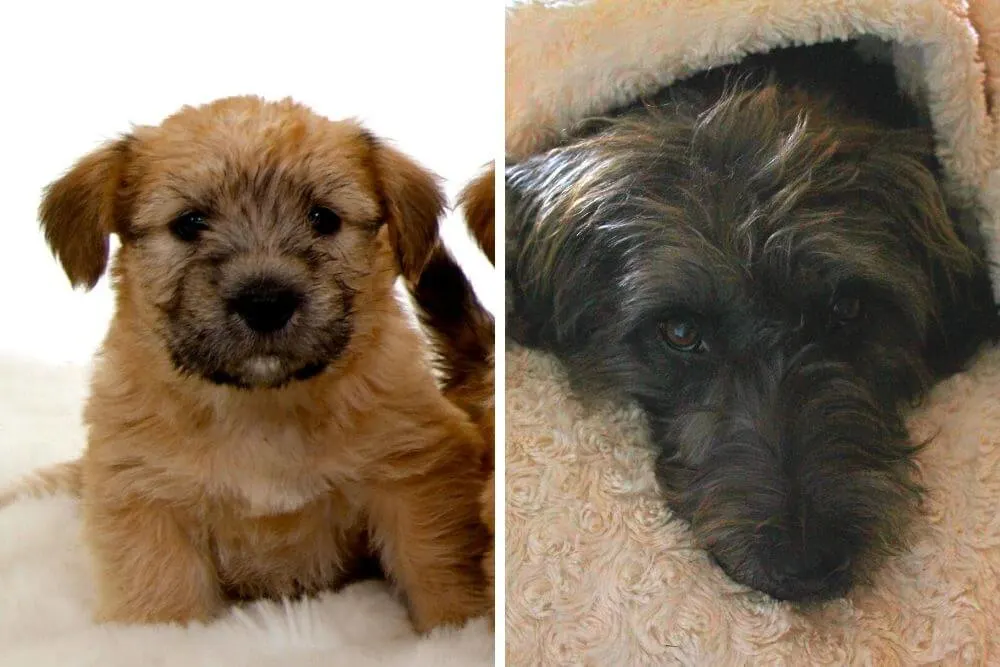
The bones in their legs are not fully formed until the dogs reach about 9 months old. For this reason it is important to ensure that Glen of Imaal puppy dogs avoid physically straining their legs while doing activities such as going downstairs or jumping off higher objects.
How much should I feed my Glen of Imaal Terrier?
What should Glen of Imaal Terriers eat as part of their diet? The diet of the Glen of Imaal Terrier should include first-rate dog food that has sufficient levels of protein. Once the dogs are about one year old, a diet of slightly lower protein seems to suit their dietary needs best. It is important to get the right proportion of food to the dog’s age, as well as activity level as these dogs can tend to put on weight, if fed too much.
Clean, fresh water should alway be available for the dog.
Consult with your local veterinary provider or animal specialist to ensure your dog gets the diet that they need.
How much exercise does a Glen of Imaal Terrier need?
How much exercise does a Glen of Imaal Terrier need? Glen of Imaal Terriers need roughly 45-60 minutes of exercise every day. This moderate level of active exercise should be made up of a mix of walking and play, ideally at regular times, for example in the morning and evening.
As mentioned before, the legs of Glen of Imaal Terriers are vulnerable up to about the age of 8 months as the bones and joints are still developing. It is important that their legs are not overly exerted with jumping activities until their legs are completely developed.
Even when their legs are fully developed, it is important to not overly push their physical limits as they need less exercise than other terrier breeds.
These dogs are also happy to entertain themselves for a while, but daily exercise is essential for them to stay healthy and fit. Otherwise Glen of Imaal Terriers tend to bark, gnaw on furniture and become frustrated.
Warning:
Although Glen of Imaal Terriers do enter water, their body shape and short legs are not suited to swimming (this also means take care near swimming pools).
Glen of Imaal Terriers Dog Training
This breed is intelligent and responds well to training, but it is essential that training dogs and socializing starts at a young age to avoid difficult behavior later on.
They respond well to positive reinforcement with treat rewards and can be a bit taken aback when given out too harshly.
Glen of Imaal Terriers that have been exposed and allowed to socialize with other dogs, as well as strangers and children, from a young age are less awkward and uncomfortable later in life.
Boredom can be a factor if repetitive dog training is used on these dogs. Glen of Imaal Terriers respond best to varied training activities over short intervals several times a day.
Opting for a short clear dog name can also help with dog training. Here are some unique Irish female names for dogs, as well as some great male Irish names too.
Can Glen of Imaal Terrier go for a walk without a leash?
As their prey drive is high, it is essential that Glen of Imaal Terriers are placed on a leash when out and about in public as the urge to chase after small animals remains high. From about 2-3 months, a dog can be trained to walk without tugging on a leash.
Glen of Imaal Terrier Hunting Dog Sports
As these dogs were originally bred as hunting dogs, they are task oriented and enjoy games that help to stimulate them such as fetch or canine sports such as agility trials, Earthdog Trials, Strong Dog Trials, Barn Hunt Trials and lure coursing.
Glen of Imaal Terriers Earth Dog Trials
Glen of Imaal Terriers perform well in Earthdog Trials. Their small size enables them to fit in small tunnels to search for their quarry, which is typically rats in these trials.
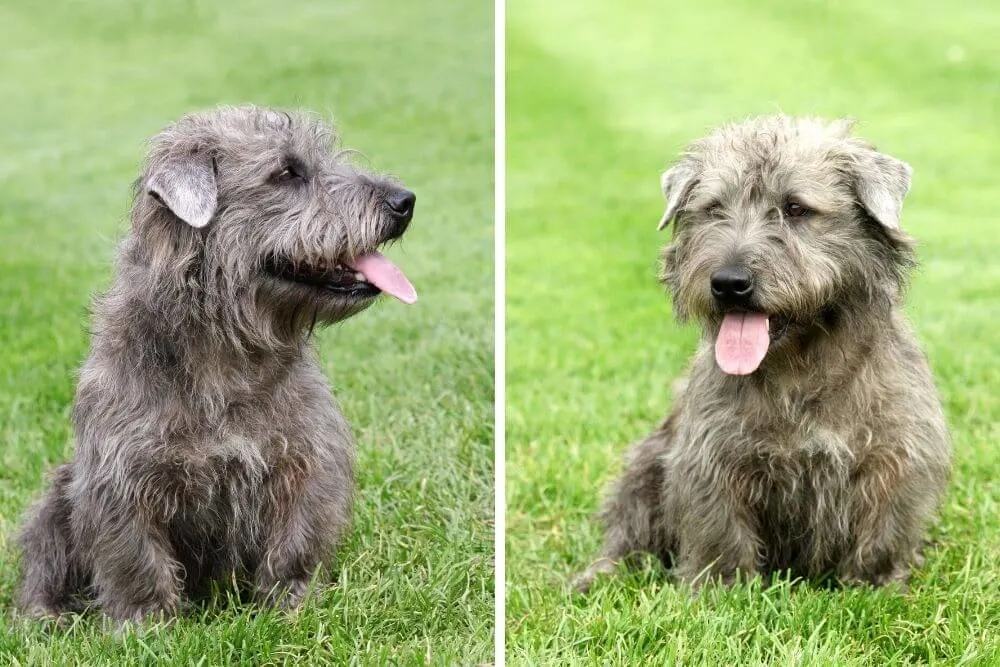
For those of you who are not familiar with Earthdog Trials, they are ability and instinct tests for small dogs such as short legged dogs, like the terrier Glen of Imaal or Dachshunds.
They are non-competitive, go-to-ground trials used to test the dog’s hunting abilities by using caged live animals in locations that replicate the original quarry hiding underground. The dogs are judged on their ability to follow the scent of a caged rat through tunnels and underground as they would have originally been bred to do.
This type of trial is particularly popular in the United States. In 1992, the European Union banned this type of trial as it is classified as a form of dog fighting under the European Convention for the Protection of Pet Animals.
Glen of Imaal Certificate of Dead Gameness
Up until the 1960s there was a particular type of trial in Ireland that was designed to test the skill of a Glen. It was known as the Teastas Misneach or Certificate of Courage.
Do Glen of Imaal Terriers bark a lot?
The Glen of Imaal Terrier bark is deep, but it is only seldom heard as they were bred to work in silence when hunting their quarry and to be awarded a Certificate of Courage, they needed to demonstrate this.
The trial required a Glen to locate a badger in a sett underground, pull it out through the narrow tunnels and “work” the badger (or prevent it from escaping) for a duration of six minutes while being completely silent.
Thankfully, these incredibly brutal trials have been outlawed in Ireland since 1966.
Many terriers are known for their tendency to bark frequently, such as the Yorkshire Terriers, Jack Russell Terriers and Teddy Roosevelt Terriers.
Glen of Imaal Terrier Temperament and Personality
These dogs are bright, bold, cheerful and good natured. Training from an early age, as well as daily exercise is essential to ensure that the dog is well balanced. They are not quite as temperamental as other terriers and commonly described as being “stoic”, but they do have a stubborn streak.
While they thoroughly enjoy activity, they can also laze around and revel in their owners’ company and attention.
Are Glen of Imaal Terriers good watch dogs?
Glen of Imaal Terriers tend to be one of the quieter terrier breeds as they were bred to work “mute to the ground” and not bark at their quarry. They can, however, be trained to be good watch dogs. Like other hunting dogs, including the Black Russian Terrier, Glen of Imaal Terriers are extremely protective of their owners.
Are Glen of Imaal Terriers good with children?
Once the dog has been socialized with kids from a young age, they are typically quite good around children and make good family dogs. However, as a rule, these dogs should never be left unsupervised with children.
Glens can be very affectionate and make good companions. While they are not large dogs, they are deceptively strong and may easily overwhelm small children.
Are Glen of Imaal Terriers good with other dogs?
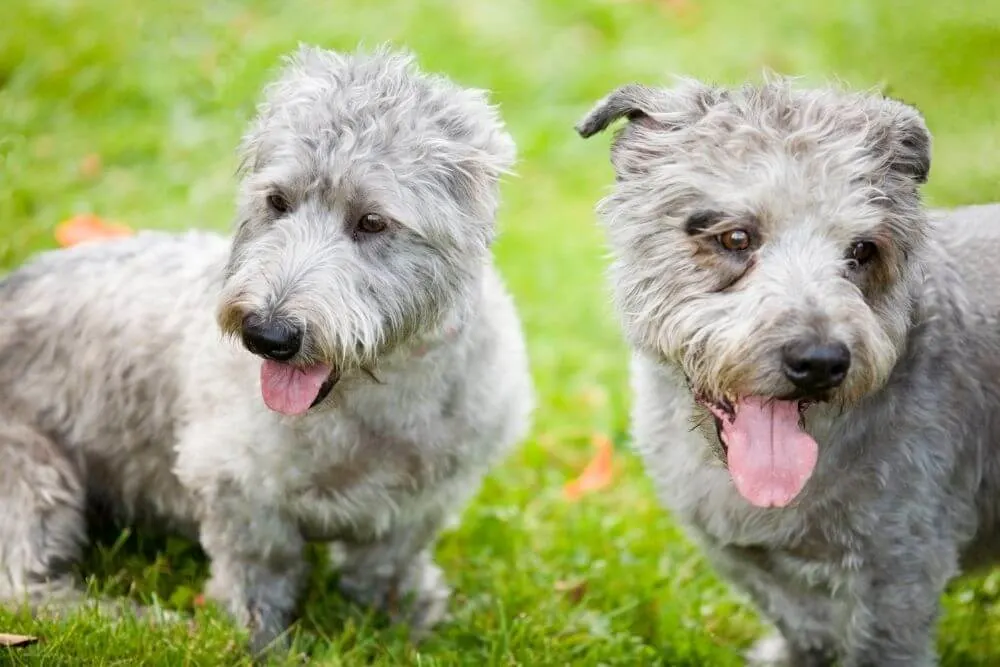
The temperament of the Glen and the amount of early socialization to other dogs can greatly influence a Glen’s ability to get along with other dogs.
While Glens generally get along well with people, especially those they are familiar with, if provoked by another dog a Glen without sufficient training can and will fight back. This is particularly the case with animals of the same sex.
It is best to ensure early socialization of this breed with other dogs, as well as good training and discipline to ensure that no unruly contact with other dogs occurs.
Can a Glen of Imaal Terrier be left alone?
If left alone for long periods, Irish Glen of Imaal Terriers can tend to get destructive so it is not advisable. They enjoy company and mental stimulation, without these elements in their daily lives, Glens are likely to get frustrated and start digging excessively or other similar behaviors.
Are Glen of Imaal Terriers aggressive?
No, Glen of Imaal Terriers are not usually known for being aggressive. However, they have a strong prey instinct and should be socialized so as not to be uncomfortable in situations with children and other dogs.
Do Glen of Imaal Terriers have a strong prey drive?
As with other dogs bred for a purpose, such as the British Fox Terrier soft haired and the Parson Russell Terrier, Glen of Imaal Terriers love to chase, hunt and dig.
Even as domestic pets, these instincts remain strong and the dogs will chase and kill small animals such as vermin. Small pets are also likely to be seen as a hunting challenge, so it is essential to keep them separate.
One terrier term that has been used to describe the dog is “dead game”, meaning that it has a very strong fighting spirit and will continue to fight, even when the likelihood of winning the fight is very slim.
The natural digging ability of Glen of Imaal Terriers makes them good escape artists so be sure that they are kept in a well fenced area.
Are Glen of Imaal Terrier rare?
Yes, it is the rarest of the four Irish Terrier breeds and is ranked 175 out of 199 dog breeds in the US.
Despite an increase in popularity, particularly from about the 1980s onwards, the Glen Imaal Terrier breed is classed as a vulnerable native breed, as there are less than 300 registered new animals in Ireland and the United Kingdom each year.
As their numbers are so limited, some breeders and fanciers are concerned about the limited genetic diversity in the breed.
It is a vulnerable breed, with less than 300 individuals in Ireland. In fact, some estimates put the total number of Glen of Imaal Terriers world wide at roughly 2500 individuals.
Glen of Imaal Terrier Breeders
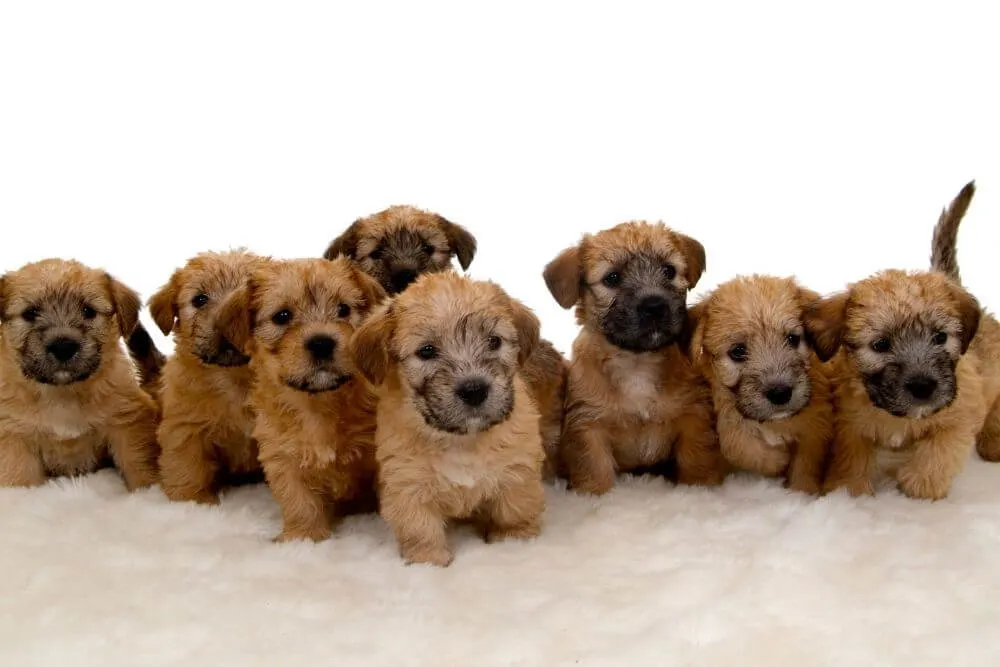
If you are getting started and would like to find out more about the Irish Glen of Imaal Terrier breed in order to determine if this is the dog breed for you, then it is worth contacting a reputable Glen dog breeder for more information.
Information about Glen of Imaal Terrier breeders can be found on the websites of the
Glen of Imaal Terrier Breed Clubs
If you are looking for Glen of Imaal Terrier puppies for sale near me, then you could also check with your local veterinary provider for some reputable contacts. There are also several Glen of Imaal breed clubs and associations that might be able to assist you in your search (or point you in the right direction).
- The Glen of Imaal Terrier Club of America (GITCA) (United States)
- Irish Glen of Imaal Terriers (Ireland)
- The Glen of Imaal Terrier Association (GOITA) (UK)
Please Note:
This is one of the breeds dog owners might have to wait for. It is also worth remembering that as this is a very rare breed, you might have to place your name on a waiting list, as the number of terrier puppy dogs is limited. (The litter size is typically 3-5 puppies).
Glen of Imaal Terrier Price Range
The price of a purebred Glen of Imaal Terrier for sale varies depending on location, gender, the breeder and whether the bloodline contains distinguished pedigree dogs, but typically the price can range from ca. US$ 1700- 2500 in the United States.
Glen of Imaal Terriers in need and Glen of Imaal Terrier Rescue Dogs
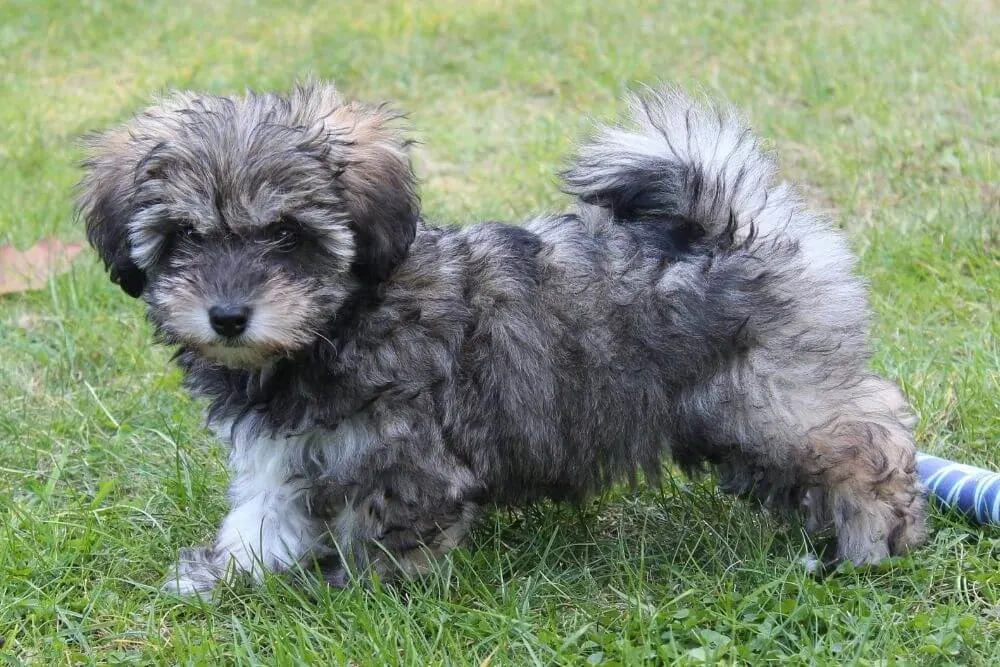
For those of you who have their hearts set on this breed, a Glen of Imaal Terrier adoption may be a better and cheaper alternative for you.
Always remember that the dog breed and individual dog will need to suit your lifestyle and location. Glen of Imaal Terriers are a special rare breed, which is known for its many good qualities. If you are looking for Irish Glen of Imaal Terrier puppies for sale or are looking for a Glen of Imaal Terrier Rescue dog, then be sure to thoroughly check if this is the dog breed for you before you bring one home.
Further costs should be factored in with medical tests. The following tests are recommended for a Glen of Imaal Terrier puppy:
- Hip Evaluation
- Elbow Evaluation
- Progressive Retinal Atrophy (PRA) Optigen DNA Test
- Ophthalmologist Evaluation
Don’t forget to factor in the costs associated with other dog related equipment such as bedding, collars, leashes and toys!
The History of the Glen of Imaal Terrier Ireland
There is a great deal of uncertainty regarding the origins of the Glen of Imaal Terrier. It is definitely an old breed possibly with ancestors from outside of Ireland. What is known is that as a working dog, the Irish Glen Terrier was bred to become an exceptionally good hunter of badgers, foxes and rodents.
Glen of Imaal Terrier Origin
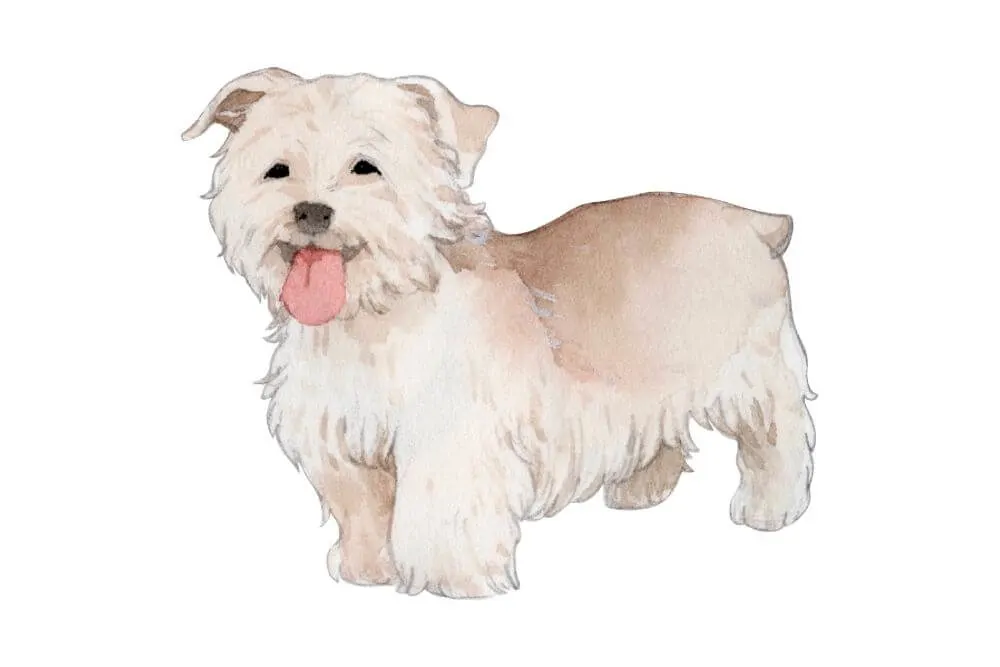
This breed has uncertain roots, but is thought to date back to as early as the late 16th century, when a possible reference appears in Chapter 65 of the “The Noble Art of Venerie and Hunting”. (Interestingly, this book is usually credited to George Turbeville, however many scholars now believe that the book was written by George Gascoigne and was only bound with the “Book of Falconry and Hawking” (1575) by Geroge Turberville.)
The reference mentions a sort of crooked legged, short haired terrier from “Flanders or one of the low countries”, that was good at going underground to hunt badgers and more persistent and determined in their task than other dogs. This description and breed characteristics is certainly similar to the Glen of Imaal Terriers we know today.
While it is possible that the Glen of Imaal Terrier may be the result of a genetic mutation, many people believe that the ancestors of this breed likely arrived with soldiers from neighboring countries who settled in the Wicklow region on the east coast of Ireland.
These soldiers could have been French and Hessian mercenaries who fought in the Nine Years’ War against the Irish under the direction of Chieftain Hugh O’Neill. The cost of the war was so great that it threatened to bankrupt the English exchequer so it is likely that these soldiers were paid in land instead for their services to Queen Elizabeth I.
David Blake Knox, in his book “The Curious History of Irish Dogs” suggests that soldiers may have been from Oliver Cromwell’s New Model Army, known as “Ironsides” who also settled in the Wicklow area.
Either way, it is likely that some of the soldiers may have brought their own small, low slung and possibly crooked legged dogs with them. Some possible suggestions include Petit Basset Griffon Vendéen (PBGV) or Basset Fauve de Bretagne who later bred with other native dogs in Ireland. This is likely to explain why there is more than just a small resemblance to the Irish Soft Coated Wheaten Terrier.
Genetically, the dogs are related also to mastiff type dogs, which adds another puzzling piece in the search for the origin of this breed.
Glen of Imaal Terrier Working Dog
This small, brawny, versatile dog would have aided the settlers as they established themselves as farmers in a mountainous area that is not well suited to farming.
The dog probably started off as a dog to catch rodents and small game. The short legs, quick reflexes and agility of the Glen of Imaal Terriers enabled the dogs to catch small animals that could have been used to supplement the settlers diet. As well as hunting outside, these dogs could have also been used to eradicate vermin from the homes.
As the breed developed, the stature of the animal, such its bowed legs assisted the animal in digging. In addition to being strong and having a powerful bite, the dogs also showed fearlessness or “dead game” when hunting badgers. This is no small feat. In order to reduce the likelihood of injury from a badger attack for example, the ears of the Glen of Imaal Terrier are folded close to its head and placed well back.
There is also some debate as to whether this breed was used as a Turnspit Dog. This would involve the dogs walking on a device like a treadmill that would turn a system of levers and pulleys and rotate meat over a fire. Given the location and the poverty of the farmers who lived in the Glen of Imaal and surrounding area, this may be a bit far-fetched.
However, it has been suggested that the dogs may have had a somewhat similar task of operating a butter churn instead, which seems to be a more plausible explanation behind this story.
Glen of Imaal Terrier Dog Show
The first record of an Irish Glen of Imaal Terrier First appearing in a dog show dates back to the Lisburn Dog Show of 1870. In the category of Irish terrier (a mixed breed class unlike the four distinctive native Irish terrier breeds of today), the winning dog was “not high on leg, longer than tall, not straight in front, turned-out feet and a slatey-brindle color.” It was also the “useful type of Irish terrier one associates with County Wicklow.”
Known for its “antique” terrier features, this dog breed was typically seen as a useful working dog, but never really became a particularly popular dog breed and almost died out towards the end of the 19th century. It was largely a forgotten dog breed and most certainly undervalued.
Glen of Imaal Terrier Recognized Breed
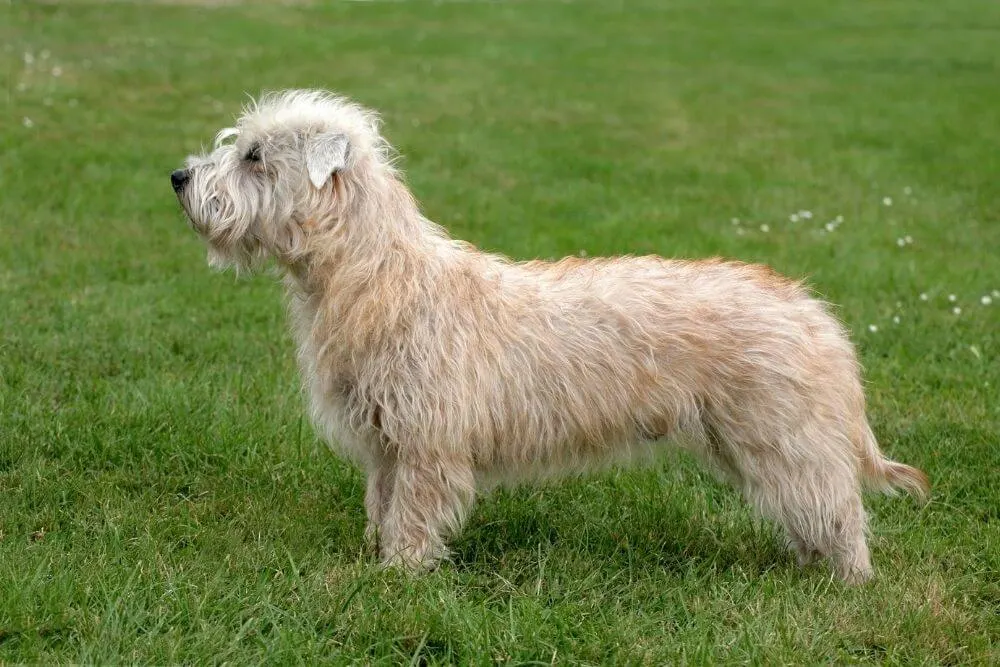
In fact it was only the third breed of Irish terrier to be recognized by the Irish Kennel Club. On St. Patrick’s Day in 1934, the Glen of Imaal Terrier became an officially recognised breed and the breed standard was written shortly afterward. (The Irish Terrier was recognised in 1875 in Glasgow, Scotland and the Kerry Blue Terrier in 1922.)
By the time World War II had come to an end, the number of Glen of Imaal Terriers was very low and the breed was once again threatened with extinction. Thanks to the revival by some Irish breeders, numbers increased and over the next few decades the popularity of the Glen of Imaal Terrier did too.
While there are some records to suggest that Glen of Imaal Terriers were brought to the United States as early as the 1930s by Irish immigrants, it was only in 2004 that the breed finally became recognized by the American Kennel Club. In 2017, the Canadian Kennel Club recognised the breed.
Glen of Imaal Terrier Today
This vulnerable breed is not a particularly popular one, despite its many charms. There are some different Glen of Imaal Terrier mix dogs available, but it is the true breed that devoted Glen owners and fanciers are trying to preserve.
The local breed clubs are probably the best way to find out more information about this breed in your general locality.
Native Irish Dog Breeds
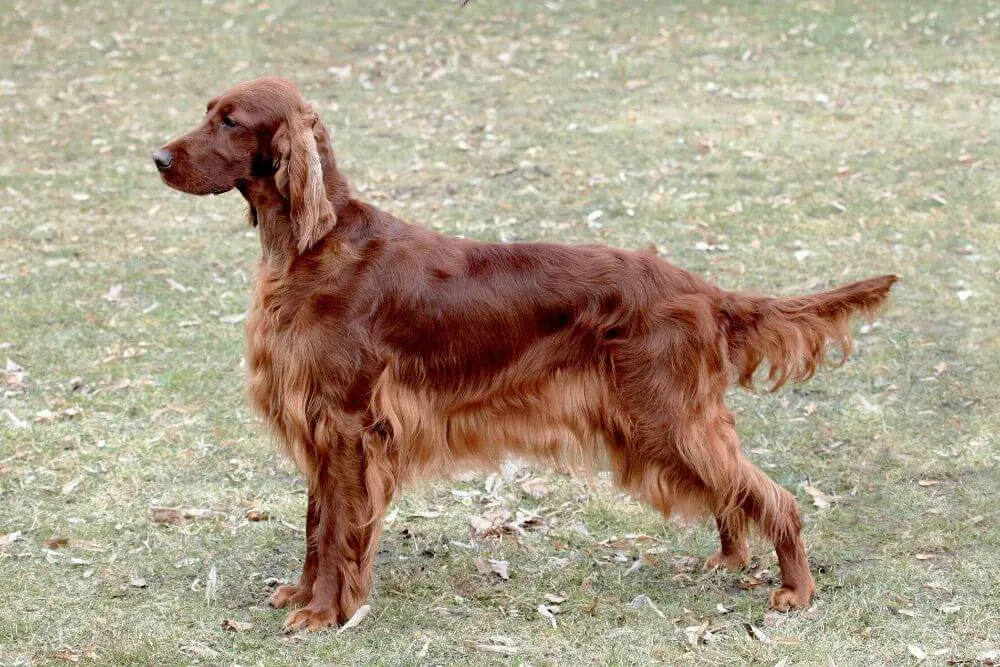
There are nine native Irish breeds of dog. The Glen of Imaal Terrier is just one of four native Irish Terriers, the other three breeds being the feisty Irish Terrier, the silky Irish Soft Coated Wheaten Terrier and the striking Kerry Blue Terrier.
The two Irish hounds include the large Irish Wolfhound and the little known Kerry Beagl. The three Irish Gundogs are the famous Irish Setter, the lesser known Irish Red and White Setter and the curly haired Irish Water Spaniel.
There is also a relatively recenet addition called the Irish Doodle, which is a mix of an Irish Setter and Poodle.
Of all of the nine Irish breeds of dog, the Irish Wolfhound and the Irish Setter are probably the best well known, while the Kerry Beagle and the Irish Water Spaniel are exceptionally rare. The Soft Coated Wheaten Terrier is the most popular of all the Irish dog breeds in the United States.
With the exception of the Irish Wolfhound, Irish Setter and the Irish Soft Coated Wheaten Terrier, all of the Irish breeds are considered vulnerable.
Each one of these breeds has their own charming personality, but also their unique history which is deeping entwined in Irish culture including involvements in World War I and the movement for Irish independence in the 1920s.
Discover the fascinating facts in our Guide to Irish Dog Breeds. It is filled with dog breeds Glen lovers will enjoy!
Related articles: Names for Pets from Ireland and feline names from Ireland
Please note that this article is only for general information purposes about the Glen of Imaal Terrier breed and should not be used as a substitute for health, medical and pet care advice from veterinary specialists.

(Irish Nature Expert and Celtic Enthusiast from Ireland)
Emer Walker, founder of LetsGoIreland.com, is a Cork native with profound expertise in Irish nature and ecology. Holding a PhD in Restoration Ecology and backed by extensive research in ecological sciences, she’s delved deep into Ireland’s natural wonders, from its rugged landscapes to its serene beaches. Emer’s passion also encompasses Celtic art and traditions. As a true authority on Ireland’s natural and cultural heritage, she invites readers through LetsGoIreland.com to immerse themselves in the authentic Irish experience.
